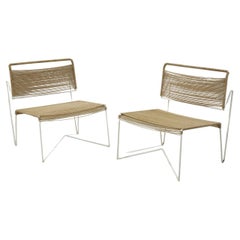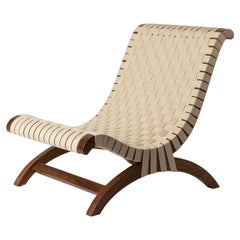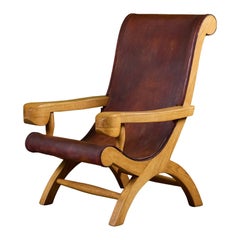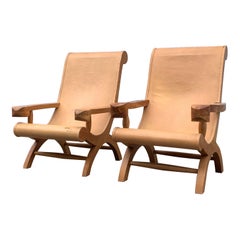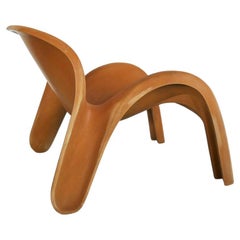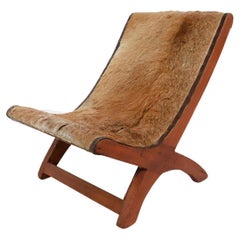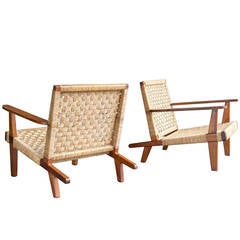Clara Porset Seating
Cuban-born mid-century furniture maker and interior designer Clara Porset is having a moment in museums such as New York’s Museum of Modern Art and beyond, with attention being paid not just to her designs for chairs, lamps and tables but to her life story, with its ties to feminism, modernization and the identification of value in indigenous materials and methods.
Born into a wealthy Cuban family, Porset studied at Columbia University, the Sorbonne and Black Mountain College in North Carolina, which she attended at the urging of Bauhaus founder Walter Gropius and where her teachers included Josef and Anni Albers.
A critic of Cuba’s right-wing government, she left her home country for Mexico, with its more simpatico regime, in 1935. With her Mexican husband, painter Xavier Guerrero, she threw herself into studying that country’s design traditions, and together the two were winners of MoMA’s Organic Design in Home Furnishings competition in 1941. (Porset was unfortunately not recognized at the time for her contribution but has since been credited alongside her husband for the entry.)
Like Porset, other designers of the mid-century era such as Cynthia Sargent, Don Shoemaker and the Bauhaus-trained architect Michael van Beuren who had relocated to Mexico found inspiration in their adopted country. Klaus Grabe, Morley Webb and van Beuren were also named among the Mexico-based winners of MoMA’s 1941 competition. (And van Beuren's furniture brand Domus produced Porset's designs in addition to his own.)
Fascinated by a Spanish-inflected Mexican wood-and-wicker chair called the butaque, Porset developed her own version by tweaking proportions and incorporating new materials.
According to art critic and curator Ana Elena Mallet, its design was “a manifestation of her profound engagement with Mexican craft traditions” at a time when “discussions surrounding the definition of Mexican identity were paramount within the larger political landscape.” In this view, “Porset’s Butaque becomes not merely a chair but a tangible expression of the socio-political discourse of its time,” she says. Or, as Paola Antonelli, MoMA’s senior curator of architecture and design, told the New York Times, “This is the Latin American chair.”
Porset designed many other chairs, some in collaboration with the preeminent Mexican architect Luis Barragán. She returned to Cuba in 1959, after Fidel Castro came to power, with high hopes, but when her plans to start a design school (under Che Guevara, Castro’s minister of industries from 1961 to 1965) foundered, she returned to Mexico, where she continued to promote design for the rest of her life.
Find vintage Clara Porset furniture for sale on 1stDibs.
Mid-20th Century Mexican Mid-Century Modern Clara Porset Seating
Metal
2010s Mexican Mid-Century Modern Clara Porset Seating
Walnut, Hemp
2010s Mexican Mid-Century Modern Clara Porset Seating
Hide, Maple
2010s Mexican Mid-Century Modern Clara Porset Seating
Rattan, Walnut
1940s Mexican American Colonial Vintage Clara Porset Seating
Steel
1970s Mexican Organic Modern Vintage Clara Porset Seating
Oak
1950s Mexican Organic Modern Vintage Clara Porset Seating
Oak
Mid-20th Century Mexican Modern Clara Porset Seating
Brass
Late 20th Century European Mid-Century Modern Clara Porset Seating
Plastic
1950s Mexican Mid-Century Modern Vintage Clara Porset Seating
Wood
2010s Mexican Minimalist Clara Porset Seating
Leather, Walnut
1940s French Mid-Century Modern Vintage Clara Porset Seating
Oak
1950s Swedish Mid-Century Modern Vintage Clara Porset Seating
Beech
2010s Mexican Modern Clara Porset Seating
Hardwood
1960s Mid-Century Modern Vintage Clara Porset Seating
Metal, Steel
1970s Italian Mid-Century Modern Vintage Clara Porset Seating
Leather, Wood, Cowhide
21st Century and Contemporary Moroccan Clara Porset Seating
Wicker, Rattan
1950s American Vintage Clara Porset Seating
Iron
1950s Mexican Mid-Century Modern Vintage Clara Porset Seating
Leather, Cane, Wood
1960s American Mid-Century Modern Vintage Clara Porset Seating
Naugahyde, Walnut
1950s Mexican Mid-Century Modern Vintage Clara Porset Seating
Cord, Wood
